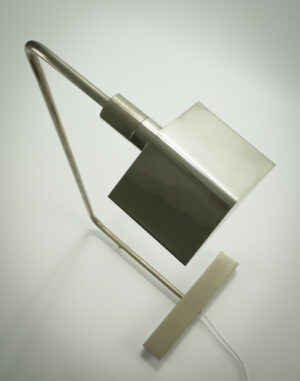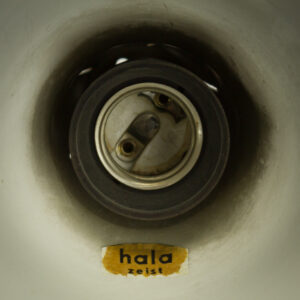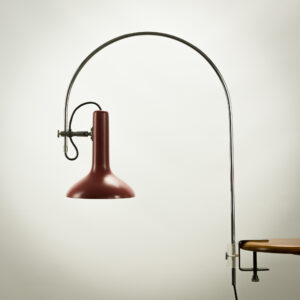One set of two Ezio Didone wall lamps for Arteluce
Italian lighting design company Arteluce was established in 1939 by the young Venetian designer-entrepreneur Gino Sarfatti. Political upheaval at the time forced Sarfatti to abandon his aeronautical engineering degree in Genoa and move with his family to Milan. There, despite a lack of formal design training, Sarfatti embarked on a lighting career. Yet it is arguably because he was wholly self-taught that Sarfatti immersed himself in the full lifecycle of the design process, from conception to production, collaborating with artisans and architects to create stronger, lighter, and cheaper modernist lamps than Italy has seen before.
During the Second World War, Sarfatti fled to Switzerland, returning to Milan after the war to restart his company. In 1951, Arteluce’s first retail outlet opened on the bustling Corso Vittorio in central Milan (now named Corso Matteotti). The shop was re-designed by Marco Zanusso in 1953. Arteluce’s second outlet, located on the glamorous Via della Spiga, was designed by Sarfatti’s lifelong friend and fellow lighting designer Vittoriano Viganò in 1961.
Arteluce quickly established itself as a successful and visionary lighting brand thanks to Sarfatti’s commitment to technical, material, and production research. He designed over 400 lamps in his lifetime (though some sources say it was as many as 700), which are celebrated for their minimalist yet expressive aesthetic and experimental materials. In the mid-1950s, he began to work with Plexiglas, and, in the early 1970s, he pioneered the use of halogen bulbs into fixtures. Sarfatti also dedicated himself to improving every single element of a light fitting, from the switch to the wiring and the reflectors. The ultra-minimal Model 1063 (1954) would influence Italian floor lamp design for years to come. It was awarded the prestigious “Grand Prix” at the Milan Triennale and is known as the most eloquent example of Sarfatti’s purist vision of beauty in everyday objects. In the same year, Arteluce was awarded the ADI Compasso d’Oro for the Model 559 and again the following year for the Model 1055.
In the 1960s, Arteluce became a creative hub for Italy’s most talented designers, producing designs by major talents, such as Franco Albini, Cini Boeri, Franca Helg, Ico Parisi,and Massimo Vignelli. The lighting installation for the Teatro Regio opera house in Turin—one of Arteluce’s last projects, which comprised hundreds of pendant plexiglas tubes installed under the direction of legendary architect Carlo Mollino in 1972—is considered one of the company’s greatest achievements.
In 1973, Sarfatti sold his business to Flos and retired to Lake Como.
Ezio Didone was born in Milan in 1939. He graduated in architecture at the Milan Polytechnic in 1967, with a thesis in Industrial Design. He spent the first years of his professional activity in the architect Frattini’s office as a collaborator. In 1970 he opened his own studio in Milan, dealing with Industrial Design, graphic design and architecture.
From 1971 to 1975 he was part of the DAM group (Designers Associati Milano) with Studio G.14 and the architect A. Colombi, signing various ideological and programmatic manifestos on design and organizing a large exhibition of the group’s products in Milan at the Center Domus. He designs and manufactures lamps, handles, furnishing objects, household items, cutlery, upholstered furniture, chairs, tables, furniture, fabrics, electronic products, technical lamps and technical equipment for hospitals, for the most important companies in the sector. Received lots of awards and also the Business Designers Design Award for the Diva lamp produced by Arteluce Flos (1987). In 1985 he was selected by ADI for the Compasso d’Oro with the Desk model for operating lamp produced by Arteluce Flos. In 2004 he was reported by ADI for the Compasso d’Oro with the New Three Stars ophthalmic unit produced by Frastema. He also designed private homes, shops, public places and corporate offices throughout Italy and abroad.












